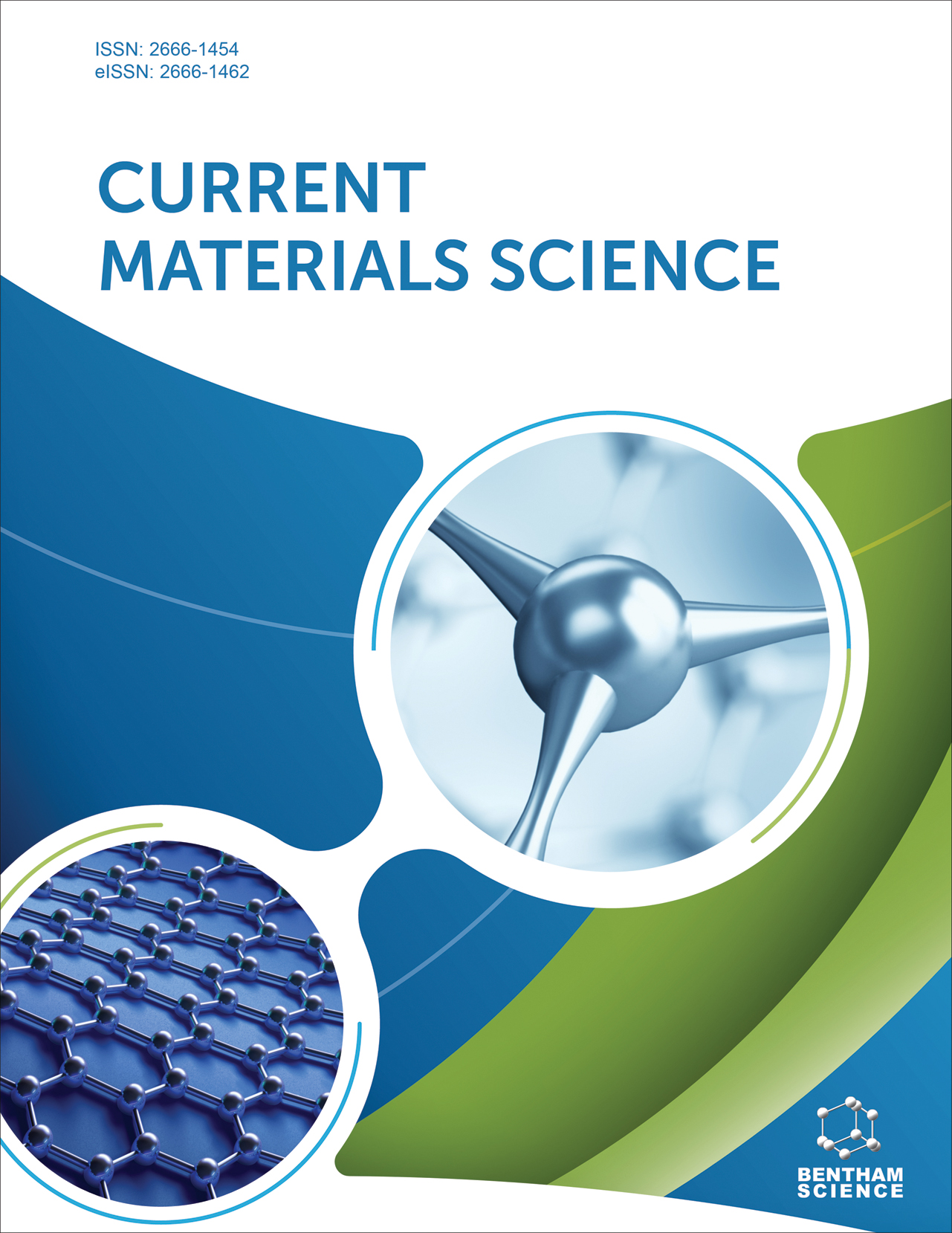- Home
- A-Z Publications
- Current Materials Science
- Previous Issues
- Volume 18, Issue 3, 2025
Current Materials Science - Volume 18, Issue 3, 2025
Volume 18, Issue 3, 2025
- Thematic Issue: Advancements in Biomaterials and Composites: Pioneering the Future of Science and Engineering
-
-
-
High-performance Electrode Material Ni(OH)2 for Supercapacitors in View of Energy Storage Applications
More LessStorage and conversion technologies are being developed in response to the extreme need to find renewable energy alternatives and reduce reliance on fossil fuels. This problem is being driven by the accelerated growth of the world economy, a high level of fossil fuel consumption, and rising serious environmental pollution. A lot of people are interested in supercapacitors due to their unique physical and chemical proper Read More
-
-
-
Ink Analysis for Forensic Investigations: An Integrated Approach Incorporating Physico-chemical Techniques and Image Processing
More LessAuthors: Sonali Kesarwani, Vaibhav Saran, Munish Mishra, Divya Bajpai Tripathy and Suneet KumarBackgroundCriminal actions using falsified papers are on the rise. Any changes to the document's content are usually made with ballpoint and gel pens. All changes made to a document using a pen necessitate ink analysis. Thus, a quick and accurate ink analysis process must be created to cope with the challenges associated with counterfeiting.AimThis study aims to analyze several brands of ballpoint and gel pen inks using Read More
-
-
-
Optimization of Control Factors Influencing the Wear Behaviour of Inflorescence Fibril Fortified Epoxy Composites
More LessAuthors: S. Karthik, R. Abinav, N. A. Kumaar, M. Hariharan, S. Induprakash, V. Akilesh and D. B. TripathyIntroductionAugmenting concern towards effective utilization of agro waste into useful products has formented the scientific community to look for alternate sources of materials. On a circular economy contemplation, natural fibers extricated from agro waste have a potential headway towards the evolution of newer materials.MethodsThe current research activity is focused on the optimization of influential parameters, namely f Read More
-
-
-
Tailoring Cu/Hydroxyapatite Catalysts for Selective Hydrogenolysis of Biomass Derived Levulinic Acid to γ-Valerolactone Biofuel Additive
More LessBackgroundSustainable synthesis of γ-valerolactone (GVL) from levulinic acid (LA) offers a sustainable approach to converting biomass-derived feedstocks into valuable chemicals and fuel additves. Cu-Hydroxyapatite (Cu-HAp) catalysts are potential candidates for vapor-phase hydrogenation of LA to GVL due to their enhanced catalytic activity and selectivity through Cu nanoparticle support.ObjectiveThis study aimed to investi Read More
-
-
-
Research Progress of 316L Stainless Steel Forming Process based on Selective Laser Melting Technology
More LessAuthors: Bingwei Gao, Liqing Peng, Hongjian Zhao and Zhixin SunSLM technology has the advantages of high material utilization, a short processing cycle and a high degree of personalization. 316L stainless steel is widely used in many industrial fields for its excellent various properties. Formed parts made of 316L stainless steel by SLM technology have expanded the application prospects of 316L stainless steel. The article reviews the research progress of the forming process of SLM-for Read More
-
-
-
In-situ Gelling Platform for Ocular Drug Delivery System: A New Paradigm
More LessAuthors: Sumbul Shadab, Md. Aftab Alam, Pramod Kumar Sharma and Deepika PaliwalOne of the most promising novel drug delivery systems is an in-situ gel, which uses a unique 'Sol to Gel' conversion to help with the slow and steady release of pharmaceuticals. An in-situ gel system enters the body as a solution but transforms into a gel once it encounters the body's internal environment. Traditional methods of ocular drug delivery, such as suspensions, eye drops, and ointments, have a number of drawbacks. Read More
-
-
-
Mechanoluminescence and Its Recent Applications
More LessBy Dipti ShuklaMechanoluminescence (ML) refers to the light emission from numerous organic and inorganic materials upon mechanical stimulation. As a brand new class of smart materials, mechanoluminescent materials are broadly relevant for fluorescence switches, mechanic sensors, protection papers, optoelectronic gadgets, record garages, and many others. In the past few years, systematic investigations have been executed, resultin Read More
-
-
-
Synthesis, Spectroscopic Characterization, and Adsorption Study of KOH Activated Limonia Acidissima (Kavat Shell Charcoal) for Removal of Metal Ion
More LessAuthors: Vaishali A. Shirbhate and Deepali P. GulwadeIntroductionCarbon is widely recognized as a unique element because of its versatile nature resulting in its variety of applications. The adsorption process is among the most effective techniques for the removal of many transition metal ions from adsorbent Kavat Shell carbon (KSC).MethodsActivated charcoal is synthesized by a chemical activation technique using KOH as an activating agent. The objective of th Read More
-
-
-
Effect of Citric Acid as a Porogenic Agent for Fabrication of Macroporous Biphasic Calcium Phosphate Scaffolds
More LessAuthors: Saeed Hesaraki, Nader Nezafati and Mostafa ShahrezaeeBackgroundA key concern in tissue engineering for bone regeneration is the fabrication of scaffolding so that it serves as a template for cell interactions and the formation of bone’s extracellular matrix to provide structural support to the newly formed tissue.ObjectiveIn the current study, different amounts of citric acid from 65 to 85 (vol%), including different particle sizes (between 250-700 μm), were used as a porogen to Read More
-
Most Read This Month
Article
content/journals/cms
Journal
10
5
false
en


